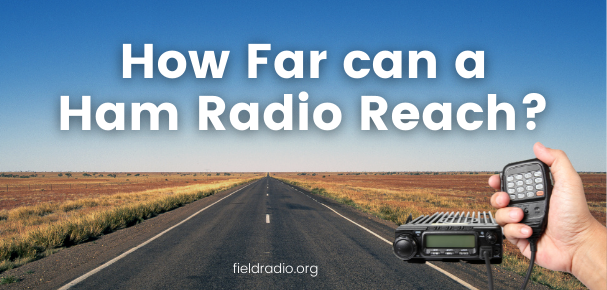Undying love for tinkering and DIYing is common among all Hams.
This passion for creation has led to the immense popularity of Raspberry Pi for Ham radio.
And with its unmatched features and easy availability, this popularity is 100% justified.
What is raspberry PI, how does it find use in Ham radio and are there any particular projects that beginners can enjoy?
You will find the answer to that and more in this fun and informative article.
Don’t miss the list of simple and interesting Raspberry Pi projects for Ham radio.
Interested in Arduino projects as well? I’ve got you covered.
Using Raspberry Pi for Ham radio is a great way to enjoy the versatility of the computer and test your creativity. The Ham radio projects you can try with a Raspberry Pi can be as endless as your imagination. You can build anything from a complex SDR to a simple clock and more.
What is Raspberry Pi?
Raspberry Pi is a low-cost and compact single-board computer. Its small size and affordability do not come at the cost of capability, as this credit-card-sized computer can do everything you’d expect from a full-sized desktop.

There are various models of the Raspberry Pi, like the Pi 3, Pi 4, etc., and each has different capabilities. One of the latest models of the Raspberry Pi has a 1.5 GHz quad-core processor with 4 GB RAM. And it is only as big as a deck of cards. So you can imagine the power.
The Raspberry Pi is just a board with all of the critical processing components mounted on it. It carries terminals for connecting the rest of the peripherals that can then turn it into a functional computer.
This tiny computer is super-affordable (usually well under $100) and features low power consumption. It runs on the Linux operating system, which further boosts the computer’s capabilities.
In Ham radio world, the functionality of Raspberry Pi is almost unmatched. From helping decode digital modes to sending and receiving data, there’s a lot you can build with it.
Using a Raspberry Pi for Ham radio has gained increasing popularity courtesy of the computer’s unmatched features which we will talk more about that in the next section.
Why Use Raspberry Pi for Ham Radio?
There is a lot that Raspberry Pi has to offer that justifies Hams’ love for it.
First and foremost, this computer is extremely affordable. While most Hams don’t mind splurging on their Ham radio-related toys, no one hates getting something as versatile as a Raspberry Pi for a price that’s no less than a bargain.
Talking about versatility, Raspberry Pi offers immense versatility, which is yet another reason for the large-scale use of Raspberry Pi for Ham radio.
Raspberry Pi sports General Purpose Input/Output or GPIO pins, giving it its inherent versatility. These pins can send and receive electronic signals, but their purpose isn’t fixed. So, you can attach any Pi HAT (Hardware Attached at the Top) that you like.
But the flexibility does not end there.
Raspberry Pi computers run on Linux operating systems which are inherently open source. This gives Hams more freedom to make the computers do whatever they like.
Another reason why Raspberry Pi enjoys such popularity among Hams is its compact size. As I have mentioned above, the board is only as big as a credit card, so Hams can easily carry them with their mobile Ham radios on their off-roading trips.
Interestingly, the HATs made for Raspberry Pi are often small in size. This makes it easier to carry them along for mobile usage.
Finally, and most importantly, the use of Raspberry Pi for Ham radio is ubiquitous.
That means you can find help whenever you come across a roadblock and easily access tutorials from Ham radio + Raspberry Pi enthusiasts like KM4ACK.
How to Setup Raspberry Pi for Ham Radio?
Now that you are probably excited about using the Raspberry Pi for Ham radio, let’s quickly talk about getting started with it.
Using a Raspberry Pi is no rocket science. However, it can be rather frustrating for people who don’t enjoy coding and computing that much.
If that’s you, fret not.
The Raspberry Pi people have thought of you as well and have made it easier for you to enjoy this computer.
I’ll tell you how in a bit.
The first step to getting started with a Raspberry Pi for Ham radio is actually buying the computer. For that, consider your requirements and then find a variant of the Pi that fits your needs.
You will also need a bunch of additional accessories to go with your Pi, like an SD card, a power supply, mouse, keyboard, etc.
The list will change and lengthen depending upon your requirements. You can even find and buy a basic Raspberry Pi kit for small-scale projects to begin with.
Once you have the physical equipment on hand, you’ll need to get your hands on the operating systems.
These operating systems are available as Zip files that you can download and burn into your SD card for free.
There are two operating systems that are largely used for Raspberry Pi, namely NOOBS and Raspbian.
NOOBS is generally recommended for beginners (go figure!) as it is much easier to use, especially for people who are not that into coding and computing.
Assemble your SD card and other accessories and boot the operating system to get started. Once the OS is booted, you may need to change the login ID and password as a first step to customize your computer.
Next, you can connect to the ethernet directly or connect a display, activate the GUI, and click on the wireless icon to connect with a wireless network.
Once you are through the basics, you can continue downloading and installing other software and updates according to the projects you are working on.
And if you cannot think of any projects to kickstart your use of Raspberry Pi for Ham radio, hop onto the next section where I have listed some fun and relatively simple Raspberry Pi projects for Ham radio.
Best Raspberry Pi Projects for Ham Radio
I know you are excited to experience the awesomeness of Raspberry Pi yourself. So, here are some of the best Raspberry Pi ham radio projects I have handpicked, with a link to their tutorials to help you get started easily. Enjoy 😊
NOAA Satellites Transmission Receiver
Do you love to watch the weather? Even if you don’t, this project is super fun as it allows you to build a Raspberry Pi-supported receiver that can catch live weather images and display each image for you to keep tabs on the latest weather updates.
You would need a Raspberry Pi 3, a 32 GB micro SD card, and an SDR dongle for this project.
Raspberry Pi Amateur Radio Digital Clock
Hams, mainly those involved in DXing, love a clock that shows multiple time zones. Raspberry Pi helps you build a UTC clock that can show times from across the world.
You can check this project out here.
A heads up, though, you may need to solder some stuff in this project. And if that isn’t your forte, consider some other project.
Satellite Tracker
Many Hams enjoy satellite communications and need to track satellites for that purpose.
A Raspberry Pi computer can help you build your very own satellite tracker with just a bunch of components and a set of electronics and computing skills.
Aviation Receiver
Another interesting Raspberry Pi project involves building a live flight tracker. This is an exciting project, especially for aviation lovers and the results it can generate are mind-blowing.
APRS Digipeater
As you may have guessed, Digipeater is a digital repeater that Hams often love to use.
KM4ACK, the Ham radio + Raspberry Pi enthusiast, has shared a thorough tutorial on building a digipeater using the Raspberry Pi 3.
You can check this tutorial here.
Final Word
The applications of Raspberry Pi for Ham radio are diverse. From building a functional repeater to a simple Ham radio clock, a complex SDR, to a super awesome flight tracker, the ideas are almost endless.
Additionally, the popularity of this nifty little computer in the Ham world has made it easier to get help. Tutorials, guides, and even complete software codes and operating systems are as close as a Google search away.
So, what’s stopping you from digging into a Raspberry Pi project? Pick a project from the list above and get building!

I have been passionate about the world of communications in its various forms for most of my life. Ever since I first found an old ham radio stashed away in my uncle’s attic, I have had a fascination with this classic technology.
Having the ability to communicate with people without the need to rely on telephone lines or networks is an empowering feeling which I believe everyone should have at least a basic knowledge of. Becuase who knows when you might need it?
I setup fieldradio.org with this passion in mind, to help inform people about the amazing possibilities of amateur radio and I’m on a quest to help educate as many budding operators as possible.
I hope you enjoy our content. Come and say hi, via our contact form


